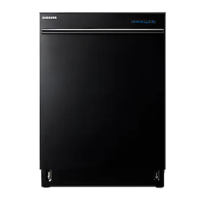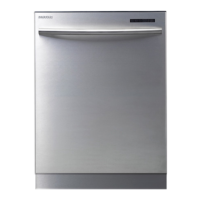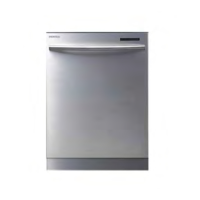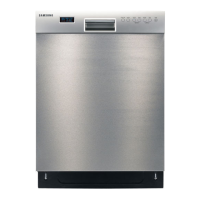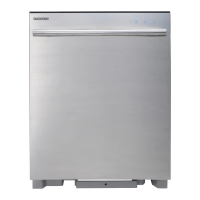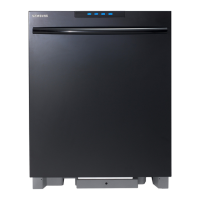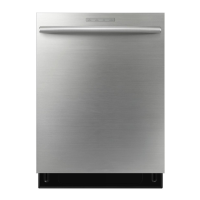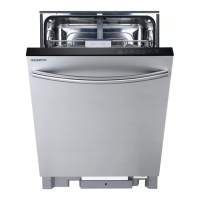How to get rid of bad odor in my Samsung DMR77 Dishwasher?
- Ccalvin11Sep 12, 2025
If your Samsung Dishwasher has a bad odor, insert detergent without loading dishes, and run the Quick cycle to clean the dishwasher.

How to get rid of bad odor in my Samsung DMR77 Dishwasher?
If your Samsung Dishwasher has a bad odor, insert detergent without loading dishes, and run the Quick cycle to clean the dishwasher.
What to do if the nozzle in my Samsung Dishwasher doesn't rotate smoothly?
| Brand | Samsung |
|---|---|
| Model | DMR77 series |
| Category | Dishwasher |
| Language | English |
Describes the upper rack's slanted design for larger dishes and maximized space.
Highlights the use of digital touch sensors for simple operation and an elegant control panel.
Explains the smart auto cycle that optimizes washing based on soil level, saving resources.
Mentions efficient noise control technology for the quietest possible operation.
Notes that the filter keeps food waste internally and drains it automatically.
Outlines critical safety instructions, warnings, and precautions for operating the dishwasher safely.
Explains the meaning of warning and caution symbols used throughout the manual for hazard identification.
Details precautions to prevent the dishwasher from tipping over during installation and use.
Provides essential instructions to avoid electric shock, including grounding and proper connections.
Guides on carefully unpacking the new dishwasher, checking for damage, and handling packaging.
Instructs users to verify all included parts after unpacking and contact customer service if any are missing or damaged.
Explains the functions of the display, showing remaining time, wash status, and error messages.
Describes the function to delay the start of a wash cycle up to 24 hours in one-hour increments.
Details the Sanitize option, which raises temperature for high-temperature sanitization in the final rinse cycle.
Explains the option to wash a small load, primarily in the upper rack, reducing water and electricity usage.
Explains how to cancel a running cycle and drain the water by holding specific buttons.
Describes how to activate/deactivate the Child Lock feature to prevent accidental operation.
Explains the operation of the Power button to start or stop the dishwasher and how it functions after cycle completion.
Use this cycle for regular dinner dishes.
Use this cycle for hard-to-clean, heavily soiled dishes, pots and pans.
Use this cycle for normally soiled dishes or fragile items like glasses.
Use this cycle for pre-cleaned dishes or glasses; no detergent used.
Use this cycle for lightly soiled dishes; detergent is dispensed but no dry cycle.
Detects soil level and initiates the optimal cycle automatically.
Details electrical requirements, including voltage, amperage, circuit breakers, and proper grounding for safety.
Provides specific instructions for permanently connected appliances to ensure proper grounding via wiring systems.
Outlines the required water pressure and tips to reduce the risk of leaks and water damage.
Emphasizes the need for a solidly constructed floor for optimal performance and stability.
Provides fundamental steps for operating the dishwasher, including loading, adding detergent, and starting a cycle.
Describes the convenience, design, and ease of use of the touch control panel and the Child-lock feature.
Explains how the dishwasher saves energy by using residual heat for drying without emitting hot steam.
Lists items that should not be washed in the dishwasher due to potential damage or discoloration.
Details how to adjust the angle of tines on plate supports in racks for better dish fitting.
Explains how to adjust the upper rack height to accommodate different dish sizes and types.
Provides instructions and illustrations for safely removing and reinstalling the upper rack.
Guides on how to load various items like plates, pots, and pans into the lower rack for optimal cleaning.
Provides instructions for loading smaller items like plates, mugs, and glasses into the upper rack.
Explains how to use the glass support for safely washing cups and wine glasses.
Describes the three compartments of the cutlery basket for organizing knives, spoons, and forks.
Explains how to use or remove the cutlery basket cover and how to handle the plastic hinge.
Provides step-by-step instructions and a table for adding the correct amount of detergent to the main and pre-wash dispensers.
Guides on how to fill the rinse aid dispenser, adjust the release amount, and its capacity for washes.
Instructions for cleaning the outside of the dishwasher, including the control panel and stainless steel surfaces.
Recommends periodic cleaning of the interior, door, and running a cycle with detergent to maintain cleanliness.
Provides steps to check and clean the lower nozzle if it becomes clogged by food particles.
Details the process for removing, cleaning, and reattaching the middle and upper wash nozzles.
Advises on proper procedures for draining, disconnecting, and storing the dishwasher for extended periods.
Presents a detailed chart outlining the different wash cycles, steps, temperatures, water usage, and times.
Lists common issues like not starting, long operation, odors, and water retention, with possible causes and solutions.
Explains various error codes displayed on the dishwasher, their meanings, and recommended solutions.
Provides guidance on environmentally responsible disposal of the dishwasher and recommended detergent usage.
Lists detailed technical specifications of the dishwasher model, including dimensions, power, and capacity.
Outlines the terms, duration, and coverage of the limited warranty for the dishwasher.
Provides contact details for customer support via phone and online for questions or comments about the dishwasher.
